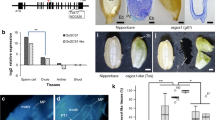Abstract
We have transformed sugar beet into a crop that produces fructans. The gene encoding 1 -sucrose:sucrose fructosyl transferase (1-SST), which was isolated from Helianthus tuberosus, was introduced into sugar beet. In H. tuberosus, 1 -SST mediates the first steps in fructan synthesis through the conversion of sucrose (GF) into low molecular weight fructans GF2, GF3, and GF4. In the taproot of sugar beet transformed with the 1-sst gene, the stored sucrose is almost totally converted into low molecular weight fructans. In contrast, 1-sst expression in the leaves resulted in only low levels of fructans. Despite the storage carbohydrate having been altered, the expression of the 1-sst gene did not have any visible effect on phenotype and did not affect the growth rate of the taproot as observed under greenhouse conditions.
This is a preview of subscription content, access via your institution
Access options
Subscribe to this journal
Receive 12 print issues and online access
$209.00 per year
only $17.42 per issue
Buy this article
- Purchase on Springer Link
- Instant access to full article PDF
Prices may be subject to local taxes which are calculated during checkout
Similar content being viewed by others
References
Delzenne, N.M. and Roberfroid, M.R., 1994. Physiological effects of non-digestible oligosaccharides. Lebensm.-Wiss. u.-Technol. 27: 1–6.
Hirayama, M., Nishizawa, K., and Hidaka, H., 1993. Production and characteristics of fructo-oligosaccharides. pp. 347–353.in Inulin and inulin producing crops. Fuchs, A. (ed.). Elsevier Science, The Netherlands
Saftner, R.A., Daie, J. and Wyse, R.E. 1983. Sucrose uptake and compartmentation in sugar beet taproot tissue. Plant Physio. 72: 1–6.
Pollock, C.J., and Cairns, A.J., 1991. Fructan metabolism in grasses and cereals. Annu, Rev. Plant Physiol.. Plant Mol. Biol. 42: 77–101.
Hall, R.D., Riksen-Bruinsma, T., Weyens, G.J., Rosquin, I.J., Denys, P.M., Evans, I.J. et al. 1996. A high efficiency technique for the generation of transgenic sugar beets from stomatal guard cells. Nat. Biotechnol. 14: 1133–1138.
Koops, A.J., and Jonker, H.H. 1996. Purification and characterization of the enzymes of fructan biosynthesis in tubers of Helianthus tuberosus Colombia. II. Purification of sucrose:sucrose 1 -fructosyltransferase and reconstitution of fructan synthesis in vitro with purified sucrose:sucrose 1-fructosyltransferase and fructan :fructan 1 -fructosyltransferase. Plant Physiol. 110: 1167–1175.
vanderMeer, I.M., Koops, A.J., Hakkert, J.C., and van Tunen, A.J., 1998. Cloning of the fructan biosynthesis pathways of Jerusalem artichoke. Plant J. In press.
Hellwege, E.M., Gritscher, D., Willmitzer, L., and Heyer, A.G. 1997. Transgenic potato tubers accumulate high levels of 1 -kestose and nystose: functional identification of a sucrose:sucrose 1 -fructosyltransferase of artichoke (Cynara scolymus) blossom discs. Plant J. 12: 1057–1065.
Van der Meer, I.M., Ebskamp, M.J.M. Visser, R.G.F. Weisbeek, P.J. and Smeekens, S.J.M. 1994. Fructan as a new carbohydrate sink in transgenic potato plants. Plant Cell 6: 561–570.
Pilon-Smits, E.A.H., Ebskamp, M.J.M., Jeuken, M.J.W., Van der Meer, I.M., Visser, R.G.F., Weisbeek, R.J. et al. 1996. Microbial fructan production in transgenic potato plants and tubers. Industrial Crops and Products 5: 35–46.
Röber, M., Geider, K., Müller-Röber, B., and Willmitzer, L., 1996. Synthesis of fructans in tubers of transgenic starch-deficient potato plants does not result in an increased allocation of carbohydrates. Planta 199: 528–536.
Huber, S.C., 1989. Biochemical mechanism for regulation of sucrose accumulation in leaves during photosynthesis. Plant Physiol. 91: 656–662.
Cairns, A.J., 1993. Evidence for the de novo synthesis of fructan by enzymes from higher plants: reappraisal of the SST/FFT model. New Phytologist 123: 15–24.
von Schaewen, A., Stitt, M., Schmidt, R., Sonnewald, U. and Willmitzer, L. 1990. Expression of a yeast-derived invertase in the cell wall of tobacco and Arabidopsis plants leads to accumulation of carbohydrate and inhibition of photosynthesis and strongly influences growth and phenotype of transgenic tobacco plants. EMBO J. 9: 3033–3044.
Pen, J., Molendijk, L., Quax, W.J., Sijmons, P.C., van Ooyen, A.J.J., van den Elzen, P.J.M. et al. 1992. Production of active Bacillus licheniformis alpha-amylase in tobacco and its application in starch liquefaction. Bio/Technology 10: 292–296.
Hall, R.D., Pedersen, C., and Krens, F.A., 1993. Improvement of protoplast culture protocols for Beta vulgaris L. (sugar beet). Plant Cell Reports 12: 339–342.
Wise, C.S., Dimler, R.J. Davis, H.A. and Rist, C.E. 1955. Determination of easily hydrolysable fructose units in dextran preparations. Anal. Ghem. 27: 33–36.
Author information
Authors and Affiliations
Rights and permissions
About this article
Cite this article
Sévenier, R., Hall, R., van der Meer, I. et al. High level fructan accumulation in a transgenic sugar beet. Nat Biotechnol 16, 843–846 (1998). https://doi.org/10.1038/nbt0998-843
Received:
Accepted:
Published:
Issue Date:
DOI: https://doi.org/10.1038/nbt0998-843
This article is cited by
-
Salt and drought stress-mitigating approaches in sugar beet (Beta vulgaris L.) to improve its performance and yield
Planta (2023)
-
Genetic Transformation in Sugar Beet (Beta vulgaris L.): Technologies and Applications
Sugar Tech (2023)
-
Expression of apple MdMYB10 transcription factor in sugar beet with a screenable marker role and antimicrobial activity
3 Biotech (2022)
-
Inulin chain length modification using a transgenic approach opening new perspectives for chicory
3 Biotech (2018)
-
Production of microbial mutan polysaccharide by expression of a mutansucrase gene (gtfI) in sugarcane
Molecular Breeding (2018)



